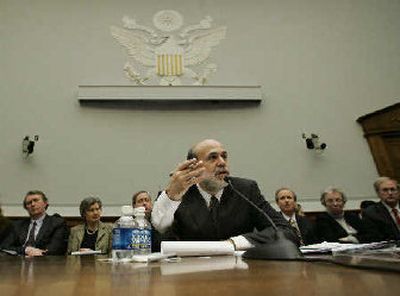New voice, same message

NEW YORK – Are we sure Alan Greenspan actually retired from the Federal Reserve?
At a minimum, you would think Greenspan’s successor, Fed Chairman Ben S. Bernanke, was channeling the iconic central banker Wednesday when the new Fed chief made his first official visit to Capitol Hill.
Sure, Bernanke’s syntax was less dense than that employed by Greenspan on similar occasions. But on substance, the two were in synch.
This was true for the big issues for central bankers – the assessment of the economy, its risks and the implications (no matter how shrouded) for interest rate policy.
The agreement extended to side issues such as what to do about growing income inequality in the United States and how best to regulate government-sponsored enterprises.
Asked about income inequality by members of the House Financial Services Committee, Bernanke talked about the “rising skill premium,” which favors people with a college education or greater.
Like Greenspan before him, Bernanke said the answer to the problem lay significantly in better education and “life-long learning” for America’s workers. Also, like his predecessor, Bernanke saw an important role in all this for the nation’s community colleges.
Sounding like Greenspan isn’t bad. The ideas expressed by Bernanke on Wednesday weren’t just in line with those of Greenspan, but with mainstream economic thinking and a bunch of unanimous votes registered by members of the Federal Open Market Committee.
Bernanke was certainly true to his words, which he repeated Wednesday, that “my intention is to maintain continuity” with the flexible approach and other practices “of the Federal Reserve in the Greenspan era.”
Bernanke also quickly cast his lot with his fellow members of the rate-setting FOMC. He said he agreed with the latest statement made by the body, which accompanied its most recent increase in the federal funds rate, this time to 4.5 percent.
He discussed the risk that the “considerable momentum” of aggregate demand might ultimately lead to higher inflation, and that the FOMC judged that in such circumstances some further tightening of monetary policy might be necessary.
Even before Wednesday’s testimony, an increase to 4.75 percent in the federal funds rate decided at the first Bernanke-led FOMC meeting in late March seemed a sure thing.
Combine it with Tuesday’s report of stronger-than-expected retail sales and two separate 25-basis-point increases to a 5 percent federal funds rate look likely by the time the May 10 FOMC meeting ends. Of course, you have to watch the data between now and then.
Interestingly for someone who has been identified with the desirability of an overt inflation target to reinforce Fed transparency, Bernanke described a near-term economic scenario that calls for the utmost Fed policy flexibility. He’s made it clear, of course, that the sort of rule he favors would not inhibit short-term flexibility.
“… It is clear that substantial progress has been made in removing monetary policy accommodation,” Bernanke said in his prepared remarks. “As a consequence, in coming quarters the FOMC will have to make ongoing, provisional judgments about the risks to both inflation and growth, and monetary policy actions will be increasingly dependent on incoming data.”
Bernanke also exhibited a long-term optimism about the U.S. economy in ways similar to Greenspan. Asked about high energy prices, Bernanke acknowledged a “zone of vulnerability” in the next five to 10 years because of a tight supply-demand balance. But he noted the economy is less susceptible to high energy prices than it was during the shocks of the 1970s. Going out beyond 10 years, Bernanke said he was “fairly optimistic” because high prices will induce innovation and conservation.